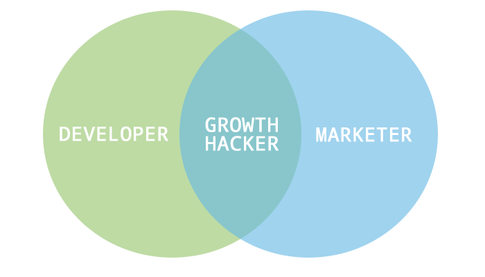What exactly IS growth hacking?
To be honest, it really isn’t a new thing.
Remember the term “hosting”? Now people call it “cloud computing”. (There’s a funny clip of Oracle CEO Larry Ellison talking about this.)
Remember the term “janitor”? Now people call them “maintenance engineer”.
Remember the term “customer representative”? Now people call them “happiness associate”.
You say tomato, i say TO-MAH-TO.
Different name, but the core is the same. Why the different name? Who knows.
“Growth hacking” has existed probably 100+ years when David Ogilvy, the “father of modern advertising” insisted that modern advertisers do direct response marketing instead of pouring their hard earned money on pretty useless ads that get no result.
Of course, at the core of growth hacking / direct response marketing is A/B testing.
But more importantly than that… HUMAN BEHAVIOR hacking with engineering.
To fully understand how you can win more customers, it’s not just who (target demographics), where (where they hang out), what (media they are consuming), why ( benefit vs. feature), etc.
You have to understand why people behave the way they do.
Do you understand what makes them tick? What their deep desires & needs are?
If you understand that, you can effectively “hack” your growth.
Here are some hacks I’ve learned over the years, that you can probably implement right away.
1) Human Behavior Hacking (Time of ad approval)
Before you continue: I’m not saying you shouldn’t push boundaries because you definitely should if you want to enhance your growth. However, avoid damaging relationships by breaking their terms of service (like using blackhat cloaking or similar tactics). Test the limits without getting into trouble. (Many shady affiliate marketers promote questionable offers in areas like dating, weight loss, gaming, and even spyware… all for quick cash). If you’re promoting legitimate products, keep on reading.
If you do advertising on, say, Facebook or some other display ad network, one of the most annoying steps is the approval process.
Here’s the dilemma: as marketers, our job is get the highest possible click through rate (CTR) to get the lowest possible cost per click (CPC).
So what gets that? Risquee stuf – overtly sexual (cleavage = guaranteed high CTR), shocking, or anything that peaks people’s curiosity.
However, there’s an issue: ad networks need to be careful with these ads because they want to avoid offending anyone and losing users. By approving these ads, they risk harming their main source of revenue (i.e., returning users). A great example is dating ads. Dating ads perform really well on Facebook, but they can be quite bothersome.
So there’s a fine line that these ad approval people have to walk. Without their users, you can’t run ads. Without the ads, they won’t make money. Without money, they can’t serve the users.
So here’s the thing.. if you do want to push the envelope with some risquee picture ad uploads, how exactly do you get around the approval process?
So here’s the trick: ads are approved around the clock. Meaning ads that are uploaded in different times of the day are approved by people in the different parts of the world.
If your appoval team is in conservative country, say, India… your approval team’s cultural perspective on what constitutes “too much” is going to be vastly different from someone whose culture is more lax… like from Europe.
I used this tactic to push some really wildly edge-y type ads on Facebook. Trick? I uploaded them during different parts of the day, even if they get rejected the first time around.
2) User appropriate (duh) user interface
Quite simply – who you view your landing page determines how it should look.
The most obvious example: if you’re targeting users who are on mobile, you shouldn’t be asking them to fill out 10 form fields.
More subtle example: suppose you sell stuff that predominantly older people are interested in – solar, reverse mortgage, retirement alternatives, etc.
Then doesn’t it make sense that the fonts should be much larger because they most likely have problem seeing?
For example, in my lead generation company days where we provided solar leads to solar sales & installation companies, our IDEAL target demographics was men 50+ homeowners who lived in sunny states with electric bill 150+.
Our landing pages converted pretty decently at around 3%.
When I doubled the font size, conversion rate shot up to 5%, and lowered the CPA (cost per acquisition) by 30%.
Yeap, one simple CSS change to the font size that saved me literally tens of thousands of dollars.
3) Using Real World Patterns
Is it raining outside in California? People are most likely staying indoors. Why not send your CA users some rain “offers” via email (like OkCupid does).
Is it 11 AM in CST? Why not send your CST users a coupon for 20% off their lunch from your food delivery service?
In another words, use the REAL world properties (or limitations) to your advantage. Be AHEAD of the trend, not behind it…. kinda like what Wayne Gretzky about getting the puck in ice hockey:
Now you can get even real creative with networks that give you demographics information like the Facebook ad platform.
Sell dresses? Lazy marketers would target female 21+. Not me because lazy people drive up ad costs because monkey see, monkey do. And monkeys chase the same thing.
I would target hispanic parents who kids are 14, so you can target them for Quinceañera (sweet 16 for Hispanics). Of course, I would do the same for bar mitzvah, sweet 16, and other cultural child-to-adult ritual celebrations.
Here’s another crazy one: sell health stuff like bandage, ointments, etc. through your ecommerce site? Odds are you’re literally bidding on “bandage” or “ointment” on search PPC… probably losing money on your initial sale, but hopefully make it up in future sell or upsell, right?
Problem is.. EVERYONE is doing that and no one is making any profits except the ad networks.
How about this instead?
Every time there’s some natural disaster, a war, or any kind of “bad news”… make a “diaster preparation kit” and target people in those areas affected. (I know because I actually made money doing this during the SARS scare in China. Oh how I love natural disasters.)
Remember, it’s not what you sell… it’s what people will buy.
Key Takeaway
Growth hacking isn’t some ph.D thing that only the top 0.1% of the population will get to use. Use innovation and common sense, and you too can be a growth hacker.



